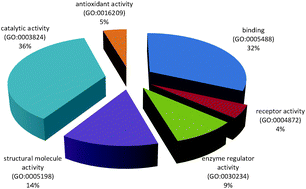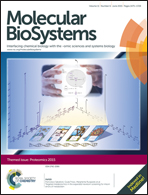Proteomic characterization of the qualitative and quantitative differences in cervical mucus composition during the menstrual cycle†
Abstract
The chemical composition of the cervical mucus (CM), its physical characteristics and the volume of secretion change cyclically throughout the menstrual cycle. The aim of this study was to identify the constitutive protein composition of CM of fertile women and the changes in the CM proteome throughout the menstrual cycle. Five fertile women who had a term delivery within 1 year before the study were enrolled. Proteomic analysis was performed using an Ultimate 3000 Nano/Micro-HPLC apparatus equipped with an FLM-3000-Flow manager module and coupled with an LTQ Orbitrap XL hybrid mass spectrometer; bioinformatic software was used for functional and quantitative analysis. 59, 81 and 43 proteins (mean) were respectively identified in the pre-ovulatory, ovulatory and post-ovulatory samples. 38 common proteins were identified. 42, 38 and 17 exclusive proteins were respectively identified in pre-ovulatory, ovulatory and post-ovulatory CM. The main part of CM constituents has a catalytic activity, which is mainly related to hydrolase activity. The label-free quantitative analysis of the common proteins revealed a significant reduction in the protein abundance index for antileukoproteinase, after the ovulation, and a peak of haptoglobin at ovulation. This is the first application of high-resolution MS-based proteomics for the identification of protein constituents of CM. This approach may contribute to the identification of putative biomarkers of the female reproductive tract.

- This article is part of the themed collection: Proteomics

 Please wait while we load your content...
Please wait while we load your content...